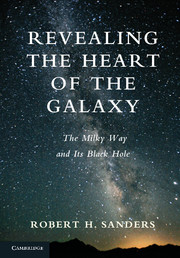Book contents
- Frontmatter
- Contents
- Acknowledgements
- 1 Introduction: The Luminous Pathway
- 2 The Discovery of the Milky Way Galaxy
- 3 The New Physics
- 4 Parting the Veil with Radio Astronomy
- 5 The Violent Universe
- 6 New Windows on the Galactic Center
- 7 The Milky Way as a Barred Spiral Galaxy
- 8 The Evolving View of Active Galactic Nuclei
- 9 The “Paradox of Youth”: Young Stars in the Galactic Center
- 10 Stellar Orbits in the Galactic Center, QED
- 11 Black Holes Here, Black Holes There…
- 12 Traces of Activity: Past, Present, and Future
- 13 After Words: Progress in Astronomy
- References
- Index
2 - The Discovery of the Milky Way Galaxy
Published online by Cambridge University Press: 05 December 2013
- Frontmatter
- Contents
- Acknowledgements
- 1 Introduction: The Luminous Pathway
- 2 The Discovery of the Milky Way Galaxy
- 3 The New Physics
- 4 Parting the Veil with Radio Astronomy
- 5 The Violent Universe
- 6 New Windows on the Galactic Center
- 7 The Milky Way as a Barred Spiral Galaxy
- 8 The Evolving View of Active Galactic Nuclei
- 9 The “Paradox of Youth”: Young Stars in the Galactic Center
- 10 Stellar Orbits in the Galactic Center, QED
- 11 Black Holes Here, Black Holes There…
- 12 Traces of Activity: Past, Present, and Future
- 13 After Words: Progress in Astronomy
- References
- Index
Summary
Kapteyn's Universe
The “hondsrug” or “dog's back” passes for a mountain range in the Netherlands. It is a ridge of sand reaching an altitude of 30 m and stretching southeast to northwest from the German border through the wooded province of Drente into province of Groningen. In fact, the most northern point is the city of Groningen, which is certainly the reason why a city is there: it is the closest point to the North Sea that is still above sea level – that is to say, on a natural geological formation. To the north of the city there are ancient small villages built on “terps,” artificial small hills created over centuries from animal and human waste, usually with a church at the highest point. Long before the construction of dikes, local farmers would gather on these terps during storms or exceptionally high tides. It is a wet and grim climate: in winter low clouds hang over the flat green treeless landscape; sunny summer days can be disrupted by sudden downpours – soaking cyclists and sending them scurrying for bridges and highway overpasses.
Groningen is a large provincial town – the central market city of this rural region. It is, by Dutch standards, rather isolated – 200 km from Amsterdam and the other metropolises of crowded Holland. Basically it bears the same relation to the Netherlands as does Novo Sibersk to Russia; from the point of view of Holland, Groningen is in the far frozen and gloomy North. But because of this relative isolation, it has developed its own dialect and culture and bustling student life. For as unlikely as it might seem, the city has a university.
- Type
- Chapter
- Information
- Revealing the Heart of the GalaxyThe Milky Way and its Black Hole, pp. 13 - 24Publisher: Cambridge University PressPrint publication year: 2013



